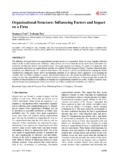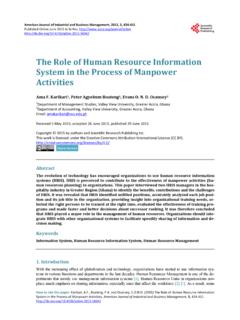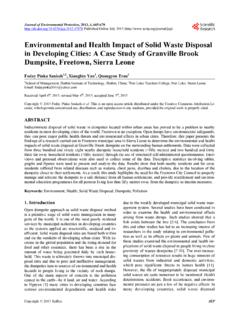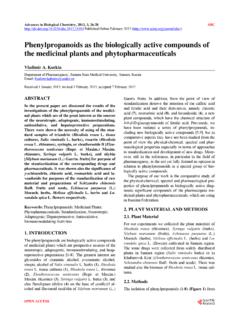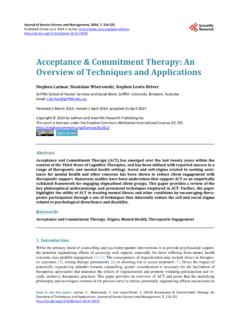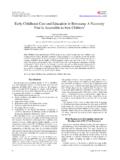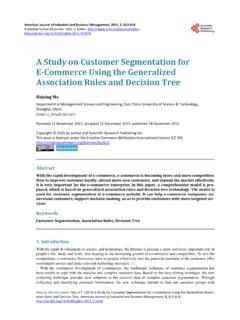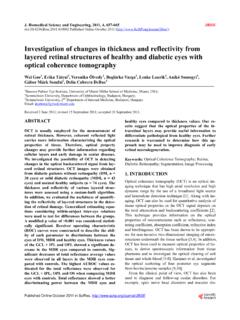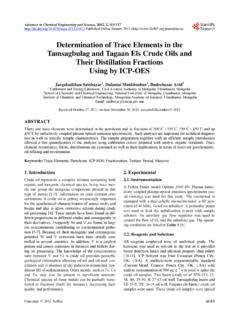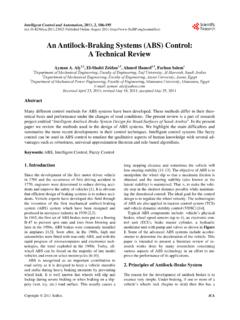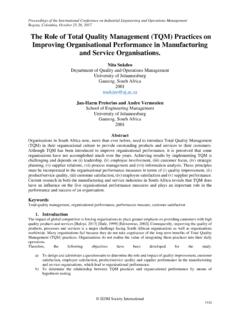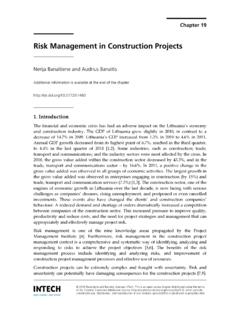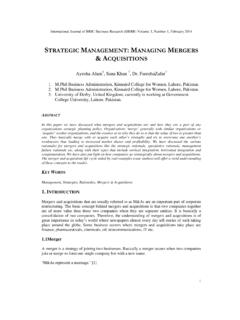Transcription of Human Resources Information System (HRIS): A Theoretical ...
1 Journal of Human Resource and Sustainability Studies, 2014, 2, 33-39 Published Online June 2014 in SciRes. How to cite this paper: Jahan, S. (2014) Human Resources Information System (HRIS): A Theoretical Perspective. Journal of Human Resource and Sustainability Studies, 2, 33-39. Human Resources Information System (HRIS): A Theoretical Perspective Sabrina Jahan The People s University of Bangladesh, Dhaka, Bangladesh Email: Received 2 April 2014; revised 6 May 2014; accepted 15 May 2014 Copyright 2014 by author and Scientific Research Publishing Inc. This work is licensed under the Creative Commons Attribution International License (CC BY). Abstract HRIS is one of the major modern HR tools. In developed countries, it became popular since the be-ginning of this century. In Bangladesh, corporate organizations have started to implement HRIS in last 5 years.
2 But still its implementation is limited within the big corporate houses. Small corpo-rate houses and public organizations have failed to realize the benefits of HRIS and taken hardly any initiative to implement the System . The major barrier to success of HRIS is the lack of man-agement commitment. The major limitation is the high cost. But the benefits of the HRIS are more than the limitations. Once it is implemented in any organization, employees and management have accepted and realized the benefits. But to get it implemented is a challenge. This study is an attempt to provide a Theoretical analysis of the HRIS implementation with analysis of benefits, li-mitations and barriers. A case study was prepared to provide a better understanding of the topic in a real life context. Keywords HRIS, HR Tools 1. Introduction Human Resource Information System (HRIS) is a systematic way of storing data and Information for each indi-vidual employee to aid planning, decision making, and submitting of returns and reports to the external agencies.
3 HRIS can be briefly defined as integrated systems used to gather, store and analyze Information regarding an or- ganization s Human Resources [1]. It merges HRM as a discipline and in particular it s basic HR activities and processes with the Information technology field. It can be used to maintain details such as employee profiles, absence reports, salary adminis-tration and various kinds of reports. It is one of the benchmark HR practices in the corporate world. In Bangla-S. Jahan 34 desh the importance of HRIS is being felt by the HR professionals and entrepreneurs. The professionals and entrepreneurs are realizing the importance of a good HR System . HRIS is one of the key components of the HR System . As a result, the importance of HRIS is increasing with the rapid growth of the corporate sectors in Bangladesh. But still there are a lot of barriers to the success of HRIS.
4 One of the major factors is the limited understanding of benefits and cost. It is still difficult to measure the return of investment in HRIS. This study has been initiated to understand the benefits, cost and barriers of HRIS in a Theoretical context. The objectives of the study are as follows 1) Understanding the need of HRIS in modern organizations. 2) Understanding applications & utilities of HRIS. 3) Understanding benefits of HRIS. 4) Understanding barriers to HRIS. The main focus of the study is the Human Resource Information Systems in modern organization. 2. Methodology Primary Source Primary data have been collected from interview with HR professionals, HR managers, and HRIS officers, soft- ware developers of different local and multinational organizations. They have provided a lot of insights and in-formation regarding HRIS. Secondary Source Secondary data have been collected from different books, journals and articles on HRIS.
5 Form of Data Collection Data collection was mainly based on material study and interview since it is a qualitative work. The respondents are mainly HR professionals, HR managers, and HRIS officers, software developers of different local and multi- national organizations. No structured questionnaire was used in the interview. The concerned people were asked tell about their experience with HRIS in terms of benefits, challenges, application and need. Limitation of Data Collection There are limited study materials on the HRIS in the context of Bangladesh. 3. Application & Utilities A standard HRIS has the following applications and utilities [2]. People administration. Payroll. Compensation and benefit. Leave and absence. Performance evaluation. Recruitment. Personal self service. Training & development. 4. Benefits The conversion process often presents opportunities to streamline business processes, improve procedures and cut HR costs.
6 With planning, you can have a painless conversion and, as an end result, a more efficient, more accu- rate HRIS [3]. The key benefits of HRIS are as follows [4]. Higher Speed of retrieval and processing of data. Reduction in duplication of efforts leading to reduced cost. S. Jahan 35 Ease in classifying and reclassifying data. Better analysis leading to more effective decision making. Higher accuracy of Information /report generated. Fast response to answer queries. Improved quality of reports. Better work culture. Establishing of streamlined and systematic procedure. More transparency in the System . Employee-Self management . 5. Limitations The limitations of HRIS are as follows [4]. It can be expensive in terms of finance and manpower. It can be threatening and inconvenient. Thorough understanding of what constitutes quality Information for the user.
7 Computer cannot substitute Human beings. 6. Challenges to Success of HRIS The challenges to success of HRIS are as follows [5]. An inconsistency in the importance attributed to HRIS resulting in difficulties in sustaining management commitment to the project and in obtaining the Resources necessary to fully develop the new or upgraded HRIS. A tendency to underestimate the complexity of the HRIS and its impact on the behavior and processes of the organization. The barriers to user acceptance of the HRIS and the consequent underestimation of the importance of change management . 7. Steps to Be Followed in Implementing HRIS The following steps are involved in developing and implementing an HRIS [6]. Step 1. Inception of idea The first step of HRIS implementation is the inception of the idea. The need of the organization to have HRIS software must be realized and agreed by the top management .
8 It is an investment and management needs to keep it in mind. Step 2. Feasibility study As this is an investment the feasibility of HRIS must be assessed. It covers the following areas Scope of the software Future benefits after implementation Potential software developers assessment Cost estimate Value addition to business ROI calculation A proper feasibility study will help the management to make the decision based on facts and figures. Step 3. Selecting a project team Implementation of HRIS is a project as it requires ensuring budgeted cost, specific timeline with quality deli-very. Successful implementation largely depends on capability and effort of project team. Project team members should be taken from both HR and IT. Involvement of senior managers is required to get the top management buy in on different issues. Experts recommend that HR and IT representatives share leadership of the project team.
9 If at all possible, project team leaders should be dedicated to conversion full time. Having a dedicated team means [the implementation] will go faster, says Gretchen Alarcon, vice president of Human capital management product strategy for the Redwood Shores, HRIS software firm Oracle [3]. Step 4. Defining the requirements S. Jahan 36 At this stage the scope needs to be defined. It will not be a detailed requirement specification but at least the processes that will be incorporated in the software. Some organization may want to develop the payroll module while others may want more modules to be developed. It all depends on the affordability and plan of the con-cerned organization. But it is an essential step before communicating with the vendor or software developers. Otherwise it will create complexity during discussion and negotiation with the software developers.
10 At this stage the company HR policies and processes must be analyzed and defined rigorously. If there is any ambiguity in process, difficulty may arise to incorporate it in the software. Step 5. Vendor analysis Selecting the right software developer is another challenge. The capability, track record and good will of the developers must be taken into consideration. The requirement of the organization must be shared with the de-velopers clearly without ambiguity. The existing processes can be clarified with them, if required. After getting clear understanding about the requirement they will come up with their offer that includes cost and specific timeline for project completion. The software requirement specification needs to be documented to avoid ambi-guity in future. Step 6. Package contract negotiation After getting the final offer from the vendors, the decision of work order will be finalized based on cost and quality actors.
